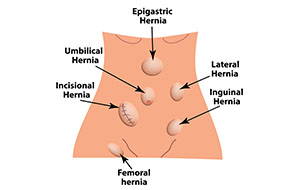What is an Inguinal Hernia?
An inguinal hernia is the most common type of hernia and occurs due to a defect in the muscle layers of the groin, resulting in a lump under the skin overlying the groin, or the scrotum. The hernia typically occurs after heavy lifting or straining, and may be painful. The lump is usually easily pushed back in (reduced) or goes back spontaneously when lying down.
Once discovered, inguinal hernias should be repaired as they tend to enlarge, become painful, and may cause serious complications such as bowel gangrene if the bowel gets stuck in the defect.
Inguinal Hernia Repair
This procedure is usually done laparoscopically via three small incisions in the midline below the umbilicus. A space is created beneath the muscle layers, which allows the defect in the muscle layers to be identified. Once found, the defect is repaired by patching it on the inside with a soft polypropylene mesh. It is common practise to inspect the opposite groin for a hernia at the time of surgery and repair it if necessary.



